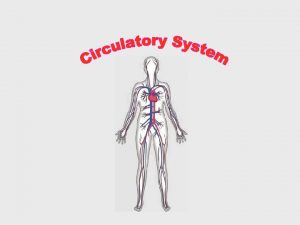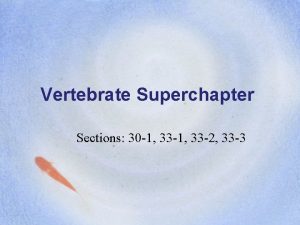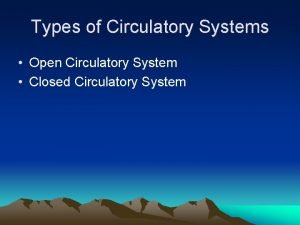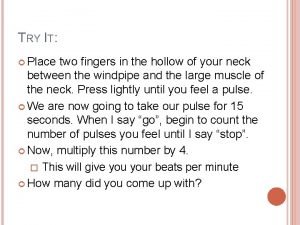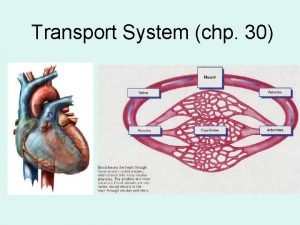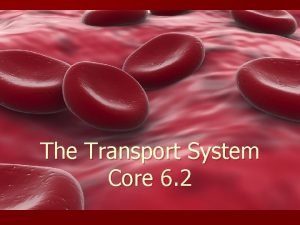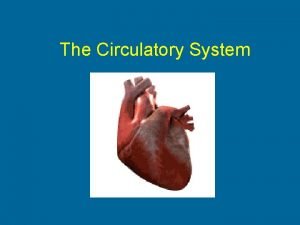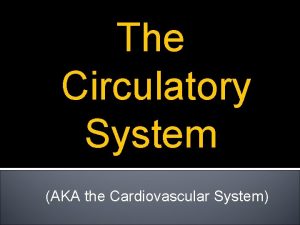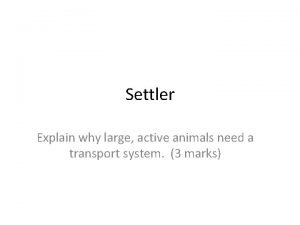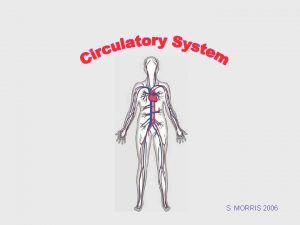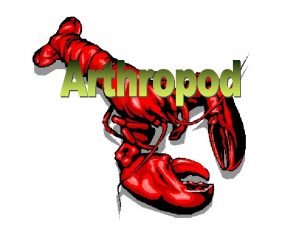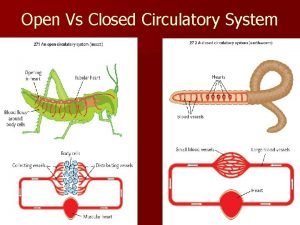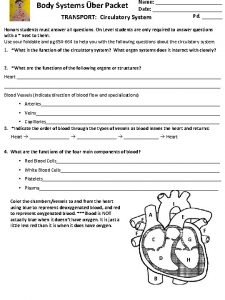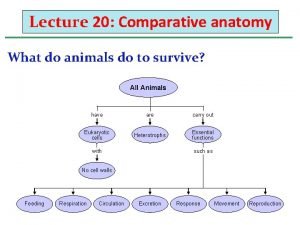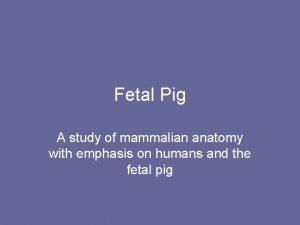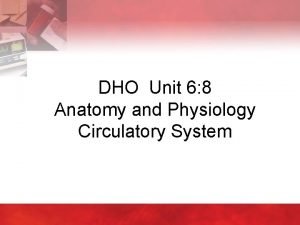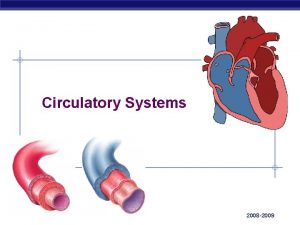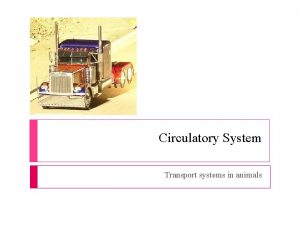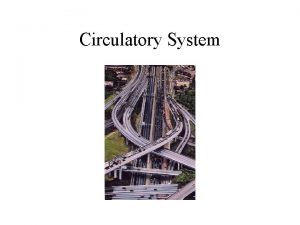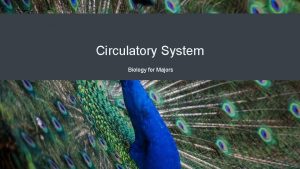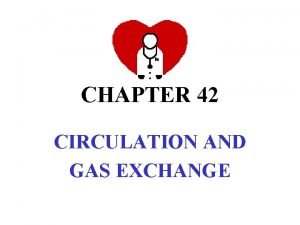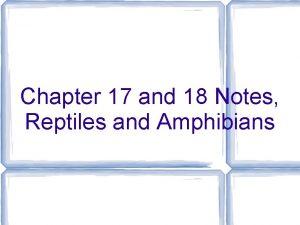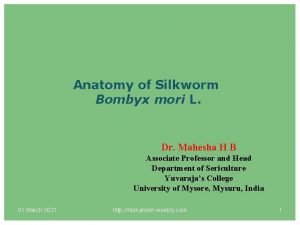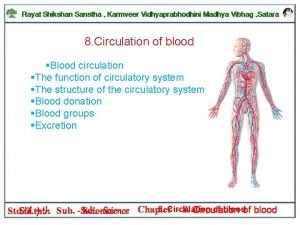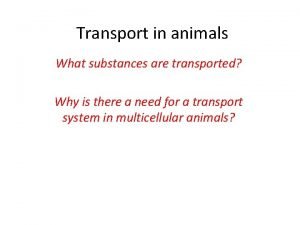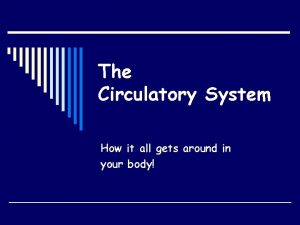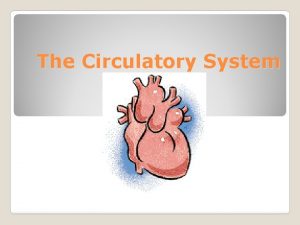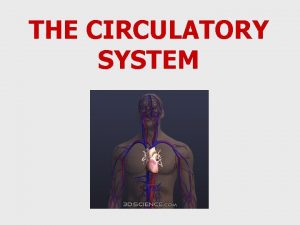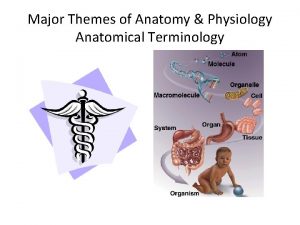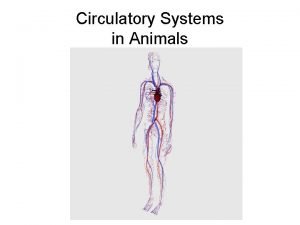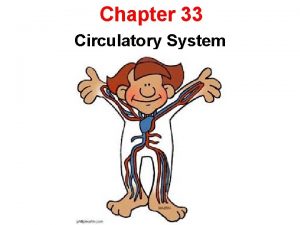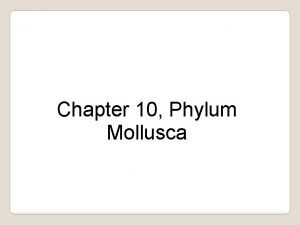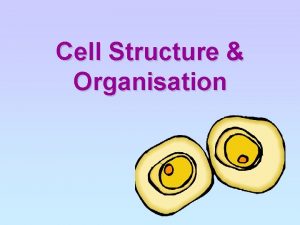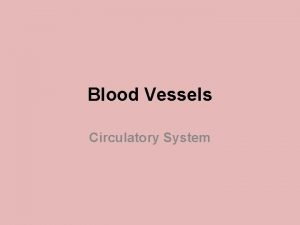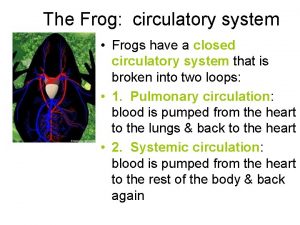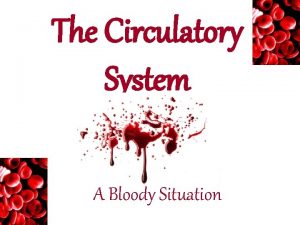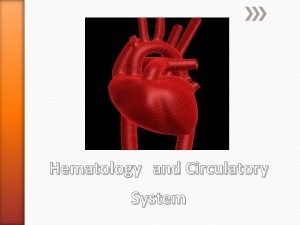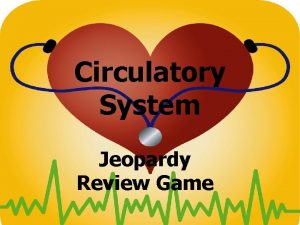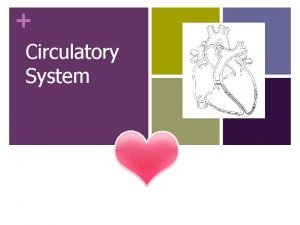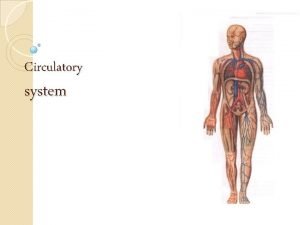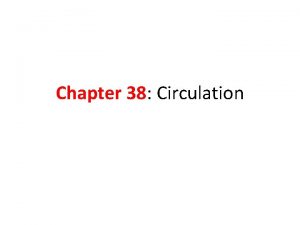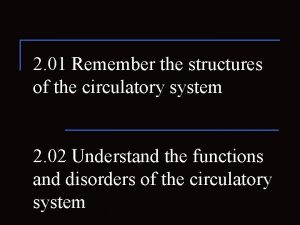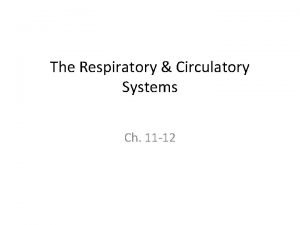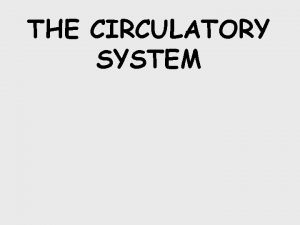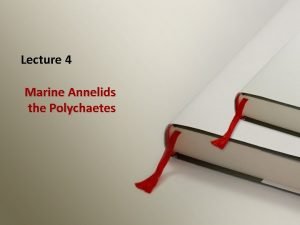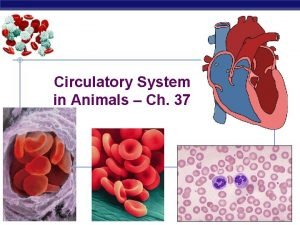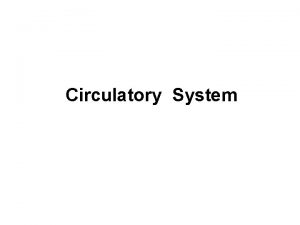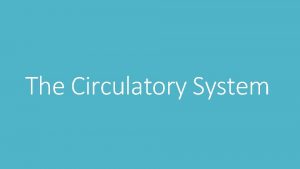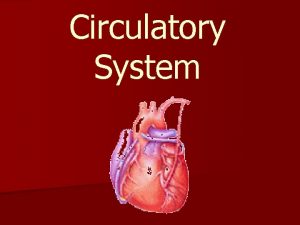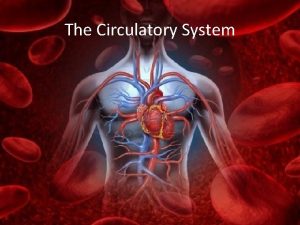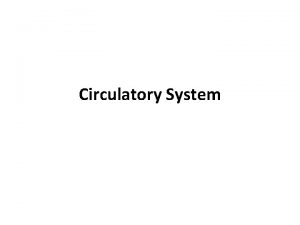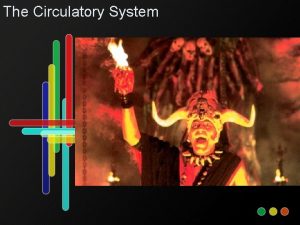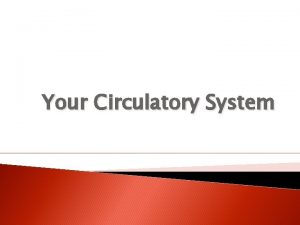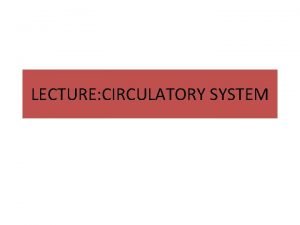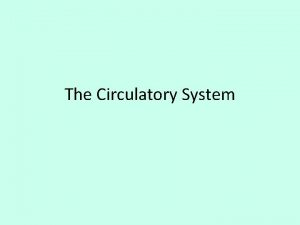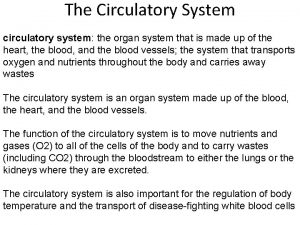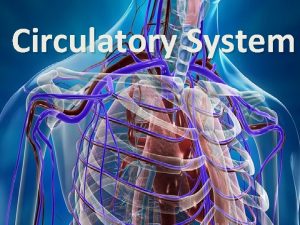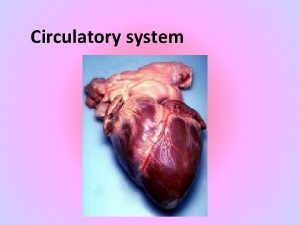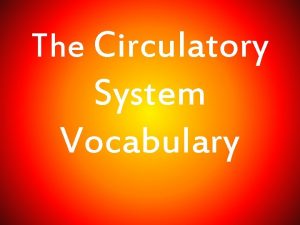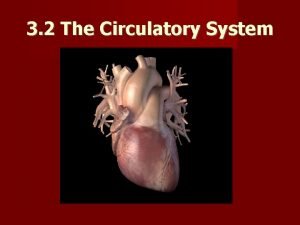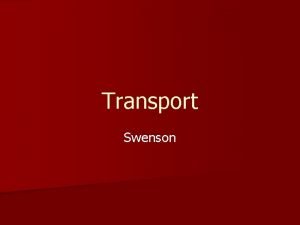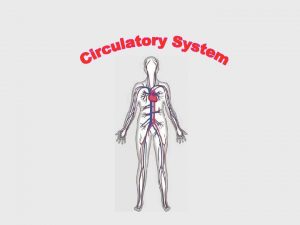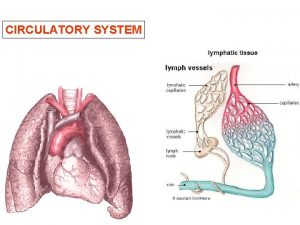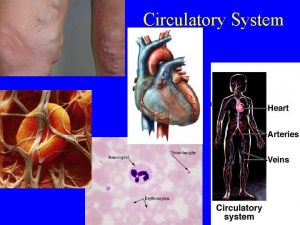The Circulatory System 1 Circulatory system n What











![Veins: – – – Carries blood[toward the heart] that contains waste and CO 2 Veins: – – – Carries blood[toward the heart] that contains waste and CO 2](https://slidetodoc.com/presentation_image_h/2eb33831530ffefd55f708a9d0bfce64/image-12.jpg)






















![n 13. aorta [oxygenated blood] n 14. Back to the body [gas exchange the n 13. aorta [oxygenated blood] n 14. Back to the body [gas exchange the](https://slidetodoc.com/presentation_image_h/2eb33831530ffefd55f708a9d0bfce64/image-35.jpg)












![DISORDERS[these are NOT in order] n Cardiovascular disease: a disease that affects the heart DISORDERS[these are NOT in order] n Cardiovascular disease: a disease that affects the heart](https://slidetodoc.com/presentation_image_h/2eb33831530ffefd55f708a9d0bfce64/image-48.jpg)











- Slides: 59

The Circulatory System 1

Circulatory system n What is the function of the circulatory system? n It carries oxygen, food and wastes through blood vessels in our body n It follows 2 pathways to accomplish this: 2

Two Pathways 1. Pulmonary Circulation – A type of circulation that carries deoxygenated blood from the heart to lungs and then back to the heart 2. Systemic Circulation – A type of circulation that carries oxygenated blood from the heart to body and then back to the heart 3

Circulatory System Consists of… n Blood Vessels n Blood n Heart 4

BLOOD VESSELS 5

n There are 3 types of blood vessels – Arteries – Capillaries – Veins 6

Arteries: carries blood Away from heart – Arteries are vessels that carry oxygenated blood from the heart to the body – They have thick muscular walls – They expand contract as blood is pumped through them in pulses – The Aorta is the LARGEST artery in the body 7

n Arterioles: small branch of an artery that carries oxygenated blood from the artery to the capillary 8

9

Capillaries – – Smallest vessel; microscopic Walls of the capillaries are one cell thick They are close to every body cell Dissolved nutrients, wastes and oxygen are exchanged between the blood and the intercellular fluid of these capillary walls 10

11
![Veins Carries bloodtoward the heart that contains waste and CO 2 Veins: – – – Carries blood[toward the heart] that contains waste and CO 2](https://slidetodoc.com/presentation_image_h/2eb33831530ffefd55f708a9d0bfce64/image-12.jpg)
Veins: – – – Carries blood[toward the heart] that contains waste and CO 2 Veins have Valves to prevent much gravity pull[backward flow] They have thin walls and no elasticity 12

BLOOD 13

n n Blood is liquid connective tissue Blood transports oxygen & nutrients to the cells of the body 8% of your body weight is due to blood Blood consist of 14

Plasma n Plasma is the yellow serum liquid portion of your blood n It consist of water and other substances n It transports hormones, nutrients and wastes n There are 4 proteins found in plasma 15

The 4 proteins found in plasma are: n 1. albumin: helps thicken the blood n 2. antibodies: fights infections and protects you from illness n 3. fibrinogen: aids in clotting n 4. prothrobin: aids in clotting 16

Erythrocytes (RBC) n Transporters of – Oxygen – Carbon Dioxide n Has a red pigment called hemoglobin n Hemoglobin oxygen carries 17

Leukocytes (WBC) n WBC fight infection and repairs injury – n Attack foreign substances There are several types of white blood cells: 18

WBC n Neutrophils fight bacterial infections n Eosinophils fight allergic reactions n Basophils release histamine to respond to a suspected infection 19

n Lymphocytes helps fight viral infections and produces antibodies n Monocytes helps fight viral infections n Phagocytes engulfs foreign matters, destroys it and removes it from the body 20

Platelets n PLATELETS are for CLOTTING blood 21

Blood Clotting Break in Capillary Wall Clumping of Platelets Clot Forms Blood vessels injured. Platelets clump at the site and release thromboplastin. Thromboplastin converts prothrombin into thrombin. . Thrombin converts fibrinogen into fibrin, which causes a clot. The clot prevents further loss of blood. . 22

23

HEART 24

characteristics of the heart n Located between the lungs n Protected n It’s by your rib cage the size of your fist 25

n It’s made up of cardiac muscle tissue n It weighs 11 oz. n It has 4 chambers and 4 valves 26

n The function of the heart is to pump and circulate blood n It beats about 68 -75 beats per minute when you’re at rest 27

Blood Flow Through the Heart ©COPY 1997 Heart. Point 28

29

30

Blood’s Path Through the Heart n 1. Vena Cava n 2. Right atrium n 3. tricuspid valve 31

n 4. right ventricle{deoxygenated blood} n 5. pulmonary valve open/closes n 6. pulmonary artery 32

Blood’s Path Through the Heart (cont) n 7. Lungs{gas exchange the blood gets oxygen, the lungs gets carbon dioxide} n 8. oxygenated blood enters back in through the pulmonary vein n 9. left atrium 33

n 10. mitral valve opens/close n 11. left ventricle n 12. aortic valve opens/close 34
![n 13 aorta oxygenated blood n 14 Back to the body gas exchange the n 13. aorta [oxygenated blood] n 14. Back to the body [gas exchange the](https://slidetodoc.com/presentation_image_h/2eb33831530ffefd55f708a9d0bfce64/image-35.jpg)
n 13. aorta [oxygenated blood] n 14. Back to the body [gas exchange the blood gets carbon dioxide and the cells get oxygen] 35

n 15. travels through veins, enters into the vena cava n 16. And then it starts ALL over again starting in the ________ 36

n The human heart is separated into left and right sides to separate oxygenated blood from deoxygenated blood n Each time blood travels from one chamber to the next, it goes through a _____ 37

Heartbeat Regulation n The force of blood from left ventricle into arteries is called a pulse n There are 9 pulse points in the body 38

Pulse points n 1. superficial temporal artery n 2. common carotid artery neck n 3. facial artery corners of the mouth 39

n 4. axillary artery armpit n 5. radial artery wrist n 6. brachial artery in front of the elbow 40

n 7. femoral artery groin n 8. popliteal artery behind the knee n 9. dorsalis pedas artery top of the foot 41

What is a pacemaker? an electrical signal that spreads outward from a spot in the wall of the right atrium to the rest of the heart n it begins each heart beat n 42

The pacemaker is also called the sinus node 43

44

What is an EKG? n a record of electrical changes in the heart 45

46

Blood Pressure n Blood against the blood vessel’s walls – The systolic pressure refers to § the pressure recorded while the ventricles pump the blood. – The diastolic pressure refers to § the pressure recorded as the ventricles fill with blood. n. A normal blood pressure is 120/80 47
![DISORDERSthese are NOT in order n Cardiovascular disease a disease that affects the heart DISORDERS[these are NOT in order] n Cardiovascular disease: a disease that affects the heart](https://slidetodoc.com/presentation_image_h/2eb33831530ffefd55f708a9d0bfce64/image-48.jpg)
DISORDERS[these are NOT in order] n Cardiovascular disease: a disease that affects the heart or blood vessels n Cardiovascular disease is caused by consuming large amounts of saturated fats 48

ATHEROSCLEROSIS -Fatty deposits called plaque builds up in walls of arteries – This condition obstructs the flow of blood 49

Hypertension n High blood pressure 50

n Heart Attack: damage to the heart muscles caused by a reduced or blocked supply of blood 51

n Stroke – Blood clot gets stuck in blood vessels leading to brain – Brain cells die due to lack of oxygen 52

n Angina pectoris: chest pain that results when the heart does not get enough oxygen n Arrhythmias: irregular heart beat 53

n Anemia: an insufficient amount of hemoglobin ; low iron n Leukemia: a disease in the bone marrow characterized by uncontrolled production of non functional white blood cells 54

Current PREVENTION Recommendations n n n Regular exercise Weight control Well balanced diet Do not smoke Diet low in saturated fat 55

Blood Types: The 4 blood types are: 56

n There are marker molecules attached to red blood cells n These markers determine your blood type n Your blood type is inherited from your parents n Type O universal donor n Type AB universal recipient 57

Rh Factor n Rhesus factor (Rh), also inherited: determines if your blood type is Rh+ or Rh – 58

n WHEW! THAT WAS WAAAAAAY TOO MANY NOTES!!!!! 59
 Site:slidetodoc.com
Site:slidetodoc.com How respiratory system work with circulatory system
How respiratory system work with circulatory system Circulatory system and respiratory system work together
Circulatory system and respiratory system work together Circulatory system steps in order
Circulatory system steps in order Section 30-1 the chordates answer key
Section 30-1 the chordates answer key Heart fish
Heart fish Does a clam have an open or closed circulatory system
Does a clam have an open or closed circulatory system Circulatory system of a cow
Circulatory system of a cow Carbon dioxide levels in the blood
Carbon dioxide levels in the blood Closed circulatory system
Closed circulatory system 3 parts of circulatory system
3 parts of circulatory system Smallest blood vessel
Smallest blood vessel Active animals
Active animals How circulatory system work
How circulatory system work What makes up the cardiovascular system
What makes up the cardiovascular system Gas exchange oxygen transport
Gas exchange oxygen transport Single circulation and double circulation
Single circulation and double circulation Arthropods respiratory system
Arthropods respiratory system Closed circulatory system
Closed circulatory system Open circulatory system vs closed
Open circulatory system vs closed Circulatory system foldable
Circulatory system foldable Invertebrate circulatory system
Invertebrate circulatory system Fetal pig phylum
Fetal pig phylum Unit 6:8 circulatory system
Unit 6:8 circulatory system Open circulatory system
Open circulatory system Open circulatory system
Open circulatory system Main function of the circulatory system
Main function of the circulatory system Circulatory system function
Circulatory system function Arthropods circulatory system
Arthropods circulatory system Difference between open and closed circulatory system
Difference between open and closed circulatory system Chapter 34 section 1 the circulatory system
Chapter 34 section 1 the circulatory system Vomeronasal organ snakes
Vomeronasal organ snakes External structure of silkworm
External structure of silkworm Function of the circulatory system
Function of the circulatory system Transport substances in animals
Transport substances in animals Circulatory system interactions with other systems
Circulatory system interactions with other systems Vena cava function in circulatory system
Vena cava function in circulatory system All parts of the heart
All parts of the heart Capillary bed
Capillary bed Feed forward mechanism
Feed forward mechanism Circulatory system interactions with other systems
Circulatory system interactions with other systems Reptile circulatory system
Reptile circulatory system Chapter 33 circulatory and respiratory systems
Chapter 33 circulatory and respiratory systems Mollusca circulatory system
Mollusca circulatory system Structure of cell
Structure of cell Blood vessels circulatory system
Blood vessels circulatory system Circulatory system frog
Circulatory system frog Circulatory system
Circulatory system Monkey circulatory system
Monkey circulatory system Circulatory system jeopardy
Circulatory system jeopardy Circulatory system trivia
Circulatory system trivia Circulatory system in a sentence
Circulatory system in a sentence The circulatory system
The circulatory system Magic school bus circulatory system
Magic school bus circulatory system Excretory system quizziz
Excretory system quizziz Salamander circulatory system
Salamander circulatory system Circulatory system
Circulatory system Tissue in cardiovascular system
Tissue in cardiovascular system Polychaete circulatory system
Polychaete circulatory system Chambered heart animals
Chambered heart animals



